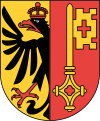Geneva
![]()
This article is about the Swiss city. For the canton of the same name, see Canton Geneva. For the locomotive of the same name, see under class SCB Ec 2/5.
Geneva (Swiss German Gämf, Gänf, Genf; French Genève [ʒənɛv, ʒnɛv]; French Provençal Geneva [ðəˈnɛva, ˈzɛnəva]; Italian Ginevra; Rhaeto-Romanic![]() ) is a city and political commune and the capital of the canton of Geneva in Switzerland
) is a city and political commune and the capital of the canton of Geneva in Switzerland
The city is located at the southwestern tip of French-speaking Switzerland (Romandie) in the Lake Geneva region at the outflow of the Rhone from Lake Geneva. With its 203,951 inhabitants (December 31, 2019), Geneva is the second largest city in Switzerland after Zurich. 47.9 percent of its residents do not have Swiss citizenship, making Geneva one of the Swiss cities with a very high proportion of foreigners, along with Basel and Lausanne. The statistical population density of 12,835 inhabitants per square kilometer is extremely high by Swiss standards. The metropolitan region of Geneva-Lausanne, with 1.2 million inhabitants, is an extended conurbation and is the most important in French-speaking Switzerland.
Along with New York City, the city of Geneva is home to most of the world's international organizations, including the UN, CERN, ICRC, WHO, ILO, IOM, ISO, IEC, ITU, WIPO, WMO, WOSM and WTO. Together with Basel (Bank for International Settlements), New York City (UN headquarters) and Strasbourg (Council of Europe), Geneva is one of the few cities in the world that serves as the headquarters of one of the international organizations commonly considered most important without being the capital of a state. In addition, 175 states have diplomatic representation here; for example, some maintain diplomatic representation in Switzerland in Geneva rather than in the federal city of Bern.
Geneva is the second largest financial center in Switzerland after Zurich, followed by Lugano. In a ranking of the most important financial centers worldwide, Geneva ranks 26th (as of 2018).
For years, Geneva has been listed alongside Zurich and Basel as part of the ten cities with the best quality of life in the world and at the same time with the highest global cost of living. In 2018, 18.6 percent of the population were millionaires (calculated in US dollars). This makes Geneva the city with the second-highest millionaire density in the world, behind Monaco.
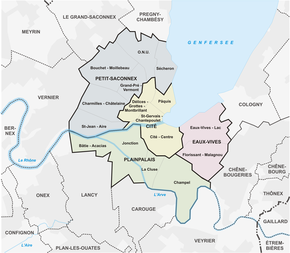
Geneva quarters

Official logo of the city of Geneva
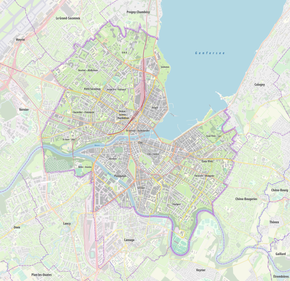
Geneva city
Geography
Location and special features
Geneva lies between the foothills of the Alps and the Jura Mountains. Mont Salève in the south of the city is considered its local mountain, but it is already on French territory. The city area is 15.89 square kilometers.
City breakdown
The urban area is composed of the four municipalities (French sections) Cité, Plainpalais, Eaux-Vives and Petit-Saconnex. The last three correspond to the municipalities incorporated in 1930. The boroughs are further subdivided into so-called quartiers:
| Section | Quarter | No. | BFS code | Area | Inhabitants | Map |
| Cité | Cité - Centre | 1 | 6621001 | 106 | 6'720 | |
| St-Gervais - Chantepoulet | 2 | 6621002 | 47 | 4'474 | ||
| Délices - Grottes - Montbrillant | 3 | 6621003 | 68 | 13'806 | ||
| Pâquis | 4 | 6621004 | 42 | 10'650 | ||
| Plainpalais | Champel | 11 | 6621011 | 180 | 17'968 | |
| La Cluse | 12 | 6621012 | 46 | 16'050 | ||
| Jonction | 13 | 6621013 | 97 | 15'704 | ||
| Bâtie - Acacias | 14 | 6621014 | 139 | 4'835 | ||
| Eaux-Vives | Eaux-Vives - Lac | 21 | 6621021 | 136 | 20'578 | |
| Florissant - Malagnou | 22 | 6621022 | 118 | 15'018 | ||
| Petit-Saconnex | Sécheron | 31 | 6621031 | 74 | 6'923 | |
| O.N.U. | 32 | 6621032 | 107 | 2'088 | ||
| Grand-Pré - Vermont | 33 | 6621033 | 62 | 10'617 | ||
| Bouchet - Moillebeau | 34 | 6621034 | 161 | 15'303 | ||
| Charmilles - Châtelaine | 35 | 6621035 | 115 | 23'537 | ||
| St-Jean - Aire | 36 | 6621036 | 94 | 9'529 |

enlarge and show information about the image
![]()
Panorama of the city with Jet d'eau (landmark), Mont Blanc and cathedral from Rive Droite (Pâquis)

enlarge and show information about the image
![]()
Panorama of Geneva seen from Salève
Climate
The annual mean temperature is 10.5 °C, with the coldest monthly mean temperatures in January at 1.5 °C and the warmest monthly mean temperatures in July at 20.2 °C. On average, about 77 frost days and nine ice days are to be expected here. There are around 60 summer days on average for the year, while 15.0 heat days are normally recorded. The MeteoSwiss weather station is located at an altitude of 411 m above sea level at Geneva Airport, about 6 km from the city center (as the crow flies).
The highest temperature ever recorded in Geneva was 39.7 degrees Celsius (July 7, 2015). The highest value for the average sunshine duration in January was reached in 2020 with 114.4 hours. This broke the previous record of 2008 (104.3 hrs).
| Geneva | ||||||||||||||||||||||||||||||||||||||||||||||||
| Climate diagram | ||||||||||||||||||||||||||||||||||||||||||||||||
| ||||||||||||||||||||||||||||||||||||||||||||||||
| Monthly average temperatures and precipitation for Geneva
Source: Federal Office of Meteorology and Climatology (MeteoSwiss) | |||||||||||||||||||||||||||||||||||||||||||||||||||||||||||||||||||||||||||||||||||||||||||||||||||||||||||||||||||||||||||||||||||||||||||||||||||||||||||||||||||||||||||||||||||||||||||||||||||||||||||||||||||||||||||||||||||||||||||||||||||||||||||||||||||||||||||

Geneva quarters
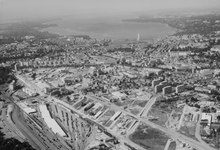
Historical aerial photograph by Werner Friedli from 1966
History
Origin and initial documentation
Geneva was a fortified border town of the Allobroges against the Helvetii in Celtic times. The place name first attested in Caesar's De bello Gallico (58 BC Genava) is conventionally traced to Celtic *genaua 'mouth' (cf. Welsh genau 'mouth'), as similarly Genoa and Arguenon. Since Geneva is not located at an estuary but at a drain, it has been suggested as an alternative to derive the name from Indo-European *genu-, *gneu- 'knee, corner, angle'.
Changing rulers until the 15th century
Geneva came under the rule of the Romans around 120 BC. At the time of the Roman Empire it served as a bridgehead, and from 400 to 1536 it was a bishop's see. In the fifth and ninth centuries it also acted as the seat of the Burgundian kings. In 563, many inhabitants were killed in the Tauredunum event, a tsunami in Lake Geneva.
Since the 10th century, the bishop of Geneva had his own silver coins minted. From 1026 Geneva belonged to the Burgundian part of the Holy Roman Empire, within which it became an episcopal territory. On August 1, 1034, the acquisition of Burgundy by Conrad II. (HRR) was celebrated in the cathedral of Geneva. The bishop's legal territory was circumscribed in relation to the claims of the Count of Geneva in the document Placitum de Seyssel of 1124. In 1162, Frederick I granted the bishopric independence and imperial immediacy. In the 13th century, Geneva became an important fair city, which brought more influence to the urban bourgeoisie. In 1387, the bishop of Geneva granted the city of Geneva various liberties, such as citizenship. In 1467, the Savoy granted the Genevans freedom of trade on their territory. Bishop Antoine Champion gathered about 500 priests in the church of St. Pierre in 1493 and denounced the vicious lifestyle of the clergy:
"People dedicated to the service of God must distinguish themselves by a pure life; but now our priests have given themselves up to all vices and lead a more wicked life than the rest of the flock. Some wear open garments, others put on warrior helmets, put on red cassocks or cuirasses, visit the markets, frequent the taverns and brothels, behave like comedians or wandering actors, take false oaths, lend on pawns, and shamefully sell indulgences to perjurers and murderers."
- Antoine Champion, Bishop of Geneva, May 7, 1493, quoted in : Jean-Henri Merle d'Aubigné: Of Huguenots and Mammelukes.
Geneva between the 16th and 18th centuries
In 1526, Geneva joined a confederation of cities together with Bern and Fribourg. After convincing sermons by Guillaume Farel, the Reformation was introduced in 1536 and the independent Republic of Geneva was proclaimed. Fribourg therefore dissolved its alliance with Geneva, whereupon the city tried several times in vain to be admitted to the Swiss Confederation as a confederated town. Only the Protestant cities of Bern and Zurich concluded a Burgrecht with Geneva in 1584. The French reformer John Calvin founded the Geneva Academy, today's University of Geneva, in 1559. After an unsuccessful attempt to invade the city one December night in 1602 (Escalade de Genève), Savoy recognized the independence of Geneva (Treaty of Saint Julien 1603). From 1540 to 1700, Geneva had become an important refuge and new home for Italian and French Protestant refugees. However, the immigrant families were not only a burden for the city, but also a social and economic enrichment through their education and knowledge in silk production and trade and in the art of watchmaking, which they brought with them and settled in Geneva and the surrounding area.
In 1781, the bourgeoisie and the working class gained supremacy, whereupon a representative-democratic constitution was adopted, before the following year, with the help of Bernese-Savoy troops, the patriciate again seized power and many industrialists emigrated as exponents of the bourgeoisie.
From City State to Swiss Canton 1798-1815
On April 15, 1798, Geneva was annexed by France. The Treaty of Unification of 26 April 1798 regulated the transfer of the Republic of Geneva to the French state. In August 1798, the city became the capital of the newly created Department of Léman. During the French period, the civil code was introduced and the city became the center of administration for the entire region, which also brought it economic benefits. However, since 1802, troops for the Napoleonic wars were also raised in Geneva.
On December 31, 1813, Geneva was occupied by Austrian troops. After first proclaiming the independence of the city republic, Geneva asked to join the Swiss Confederation. On June 1, 1814, Swiss troops landed in Geneva in accordance with the decisions of the Congress of Vienna, and on September 12, the Federal Diet officially confirmed Geneva's admission to the Confederation as the 22nd canton. The treaty of union was signed on May 19, 1815. The city of Geneva thus became the capital of the newly formed canton of the same name, Geneva. This was extended by French and Sardinian territories in the Second Peace of Paris and the Treaty of Turin, so that the Geneva area received a land connection to the rest of Switzerland. In order not to cut Geneva off economically from its surrounding countryside, several duty-free zones were successively created around Geneva, which by 1860 finally encompassed almost the entire former territory of the Département Léman.
The City Republic of Geneva minted its own coins until 1850. These were divided into sols for a certain time, as was customary in France for a long time, after which francs were minted.
In 1864, Geneva became the seat of the International Committee of the Red Cross. In 1873, the University of Geneva was founded.
At the end of the 19th century, the development of the watchmaking industry was encouraged by the construction of a pressurized water network to supply the city with energy and drinking water. The Usine des Forces Motrices, commissioned in 1886, also introduced water level regulation for Lake Geneva. The increasing energy needs of industry necessitated the construction of the Usine de Chèvres, the largest power plant in Europe at the time.
20th century and territorial expansion
From 1920 to 1946, Geneva was the seat of the League of Nations.
In 1931, the former communes of Eaux-Vives, Le Petit-Saconnex and Plainpalais were merged with the city of Geneva. On November 9, 1932, a massacre ("Blood Night of Geneva") occurred when soldiers shot 13 anti-fascist demonstrators and seriously injured 60.
21st century
Geneva is one of ten Swiss cities and one of one hundred European cities to be awarded the honorary title of "Reformation City of Europe" by the Community of Protestant Churches in Europe in 2015.
Coat of arms
→ Main article: Flag and coat of arms of the canton and city of Geneva
|
| Blading: "Split, in front in gold a red crowned, fanged and armed black half eagle at the gap; in the back in red a golden key with quatrefoil and with straight tau cross incision in the left-turned beard. » |
| Coat of arms justification: The Geneva coat of arms represents the union of the bishop (Key of Saint Peter) and the Free Imperial City (Imperial Eagle). It appeared for the first time in the 15th century. |
.jpg)
1 Sol from 1825
.jpg)
5 Francs from 1848
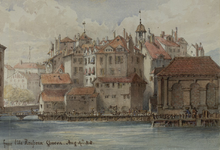
Geneva in 1858
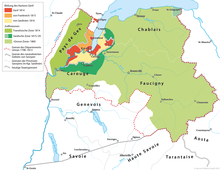
Map of the formation of the Swiss Canton of Geneva and the free zones 1814-1860
Questions and Answers
Q: What is the pronunciation of Geneva?
A: Geneva is pronounced /dʒɨˈniːvə/.
Q: How is Geneva referred to in French?
A: In French, Geneva is referred to as Genève.
Q: How is Geneva referred to in German?
A: In German, Geneva is referred to as Genf.
Q: How is Geneva referred to in Italian?
A: In Italian, Geneva is referred to as Ginevra.
Q: What part of Switzerland does it belong to?
A: It belongs to Romandy (the French-speaking part of Switzerland).
Q: What survey states that it has the third highest quality of living in the world?
A: A 2009 survey states that it has the third highest quality of living in the world (narrowly outranked by Zürich).
Q: What organizations are based in Geneva?
A: Many international organizations are based in Geneva, including the United Nations and the Red Cross.
Search within the encyclopedia
